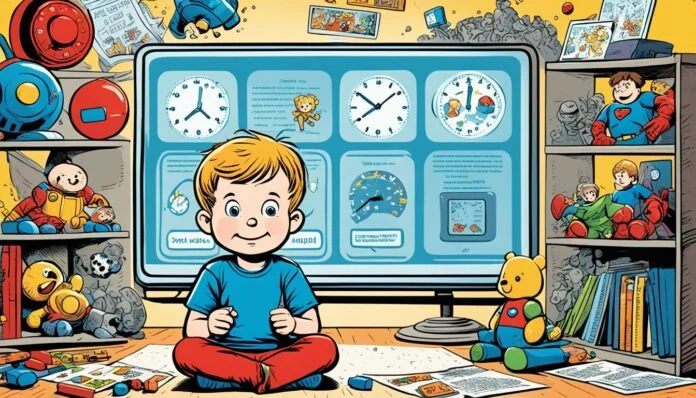
In today’s world, kids spend a lot of time in front of screens. They use educational apps, watch videos, and enjoy entertainment media. But, the amount of screen time is growing fast. This has worried parents, teachers, and doctors about its effects on kids.
Key Takeaways
- The Centers for Disease Control and Prevention (CDC) reports that children aged 8-10 spend an average of 6 hours per day on screens, while those aged 11-14 spend up to 9 hours, and teens aged 15-18 spend 7.5 hours on screens.
- Pediatricians recommend no screen time for children under 2 years old, except for video chatting, and no more than 1 hour per day of co-viewing with a parent or sibling for 2-5 year olds.
- Excessive screen time has been linked to physical and mental health issues, such as obesity, depression, behavioral problems, anxiety, and sleep disturbances.
- Developing a personalized family media use plan and encouraging alternative activities like outdoor play, sports, and hobbies can help maintain a healthy balance between screen time and real-life interactions.
- Parents should set screen-free zones, such as bedrooms and mealtimes, and use parental controls to monitor and manage their children’s screen time and content exposure.
The Alarming Statistics of Kids’ Screen Time
The Centers for Disease Control and Prevention (CDC) has shared worrying data on kids’ screen time. They found that 8-10 year olds spend about 6 hours a day in front of screens. 11-14 year olds spend 9 hours, and 15-18 year olds spend 7.5 hours. This doesn’t count screen time for schoolwork, showing many kids go way over the recommended limits.
Exploring the CDC’s Data on Average Daily Screen Time
The CDC’s data shows a worrying trend in how kids use media. For instance:
- Almost all (96.6%) of zero to 4-year-olds from a low-income clinic used mobile devices, and 75% owned one.
- Kids under 2 watch an average of 49 minutes of digital media a day, more than the guidelines suggest for this age.
- Children ages 2 to 4 watch over 2.5 hours a day, more than the recommended limit for this age.
- Children 5 to 8 watch over three hours a day, with the American Academy of Pediatrics stressing the need to ensure screen time doesn’t replace other activities.
The data also shows that screen time varies by income. Lower-income families have kids who watch about two more hours of screens daily than higher-income families.
“The American Academy of Pediatrics recommends no screen time for children under 2 years old, no more than one hour per day for children 2-5 years old, and no more than two hours per day for children 5-17 years old (excluding homework).”
Despite these guidelines, most families don’t follow the suggested screen time limits. Parents often don’t worry about the effects of screen media on their kids or the quality of content.
Understanding the Impacts of Excessive Screen Time
Too much screen time can harm both physical and mental health in kids. Studies show it can cause obesity, sleep problems, and behavioral issues. It can also hurt academic performance and increase violence exposure.
Physical and Mental Health Risks Associated with Too Much Screen Time
The American Academy of Pediatrics (AAP) found that babies 6 to 12 months old who used screens at night slept less. A 2017 study in Pediatrics linked screen time to a higher risk of obesity in kids.
Reducing screen time can boost kids’ physical activity, says a JAMA Pediatrics study. Screen time before bed can shorten and lower sleep quality. This might lead to behavior problems and poor school performance.
Too much TV and video game use can hurt kids’ grades, a Pediatrics study showed. Kids aged 5 with over 2 hours of screen time a day might have trouble focusing.
Screen overuse worries pediatricians. It can make kids less sensitive to violence and reduce creative play. This is key for their health and happiness.
“Establishing a family media plan can help set realistic limits on screen time and balance media usage with other activities.”
With digital devices becoming more common, parents must watch out for the dangers of too much screen time. They should aim for a healthy balance for their kids.
Pediatricians’ Screen Time Guidelines for Different Ages
Pediatricians are key in giving advice on how much screen time is right for kids. They help parents set up good digital habits for their kids. The American Academy of Pediatrics (AAP) has clear guidelines to help manage screen time well.
For kids under 2, the AAP says no digital media except for video chats with family. This time is important for kids to explore, interact face-to-face, and learn from the real world.
- For kids 2 to 5, the AAP suggests no more than 1 hour a day of educational shows. Parents should watch shows with their kids to make sure they’re right for the age and keep kids engaged.
- At 5 and up, kids can watch up to 2 hours of TV a day, not counting school stuff. This rule helps balance tech use with physical activity, social time, and hobbies.
Pediatricians stress the need for a family plan on media use. This plan sets limits, watches what kids watch, and encourages other activities for healthy growth. Families working together can make sure screen time is good for kids.
“Setting rules on screen time keeps kids safe online as they get older.”

Pediatricians’ advice on screen time is a guide for parents and caregivers. By knowing the limits and promoting balanced media use, families can handle the digital world. This supports kids’ health, mind, and social life.
Developing a Family Media Use Plan
As digital devices become more common, parents need to make a family media use plan. This plan helps manage how much time kids spend on screens. The American Academy of Pediatrics suggests creating a plan with clear limits. This ensures a good balance between digital and real-life activities.
Strategies for Setting Healthy Boundaries and Limits
Creating a family media use plan means using several key strategies:
- Setting screen-free zones like bedrooms and during meals helps reduce tech use. It also boosts face-to-face time.
- Setting screen time limits is based on the child’s age and needs, as advised by experts.
- Using parental controls and filters helps keep kids away from bad or harmful online content.
- Starting bedtime routines without screens helps kids sleep well and think clearly.
- Switching screen time with other activities encourages creativity, exercise, and making friends.
These strategies help parents make a plan that supports their kids’ health and growth.
“The key is to find a healthy balance and ensure that media use does not displace other important activities such as sleep, physical activity, and face-to-face interaction.” – American Academy of Pediatrics
Creating a good family media use plan needs ongoing talks and teamwork from everyone at home. By setting clear rules and balancing tech with real-life, parents can help their kids develop good media habits. These habits support their health and happiness.
How Much Screen Time is Too Much for Kids
As parents, figuring out the right amount of screen time for our kids is tricky. Digital devices are a big part of our lives now. But, too much screen time can harm a child’s health, both in body and mind.
Recent studies say that kids from birth to age 8 spend about two and a half hours a day on screens. The amount of screen time changes with age. Babies under 2 should not have more than 49 minutes of screen time daily. Kids aged 2 to 4 should watch screens for no more than two and a half hours. By age 5 to 8, kids can watch screens for up to three hours a day.
Too much screen time can have big effects. Research shows that kids who spend over two hours a day on screens do worse on tests for language and thinking. Also, kids who spend seven hours or more on screens are more likely to feel depressed or anxious. This is compared to kids who use screens for an hour or less a day.
The American Academy of Pediatrics has guidelines for screen time based on age:
- Under 18 months: No screen time, except for video-chatting with an adult
- Ages 2-5: Limit screen time to 1 hour a day
- Ages 5 and older: Set limits on daily screen time, watch media with your child, and teach them about online safety and respect
By following these guidelines and teaching good screen habits, parents can help their kids grow up healthy in the digital world. This way, kids can enjoy the benefits of technology without losing out on a balanced childhood.
Balancing Screen Time with Real-Life Interactions
Parents today face the challenge of managing their kids’ screen time. It’s key to balance digital and real-life interactions. Doctors say it’s vital to focus on activities that help kids grow, along with setting limits on screen time.
The Importance of Face-to-Face Communication and Play
Talking face-to-face is crucial for a child’s social growth. It helps them learn about empathy, patience, and managing feelings. Playing and being outside boosts creativity, problem-solving, and happiness.
- The American Academy of Pediatrics says kids under two should avoid screens. They suggest talking, playing, and reading instead.
- By age 5, kids can start learning from digital media, but keeping a balance is key.
- Experts advise turning off screens two hours before bed, waiting an hour after waking, and mixing screen time with sleep, exercise, play, and reading.
Too much screen time can lead to health problems like obesity, anxiety, and trouble focusing. Limiting screen time and focusing on real-life talks and playing outside helps kids grow socially and mentally. It also keeps a healthy balance between tech and life.
“The more a child engages in face-to-face social interaction, the better they will develop critical social and communication skills essential for healthy development and relationships.”

By balancing tech use with real activities, parents help their kids enjoy technology’s perks. They also keep the door open for social growth and creativity through real talks and playing outside.
Monitoring and Controlling Content Exposure
In today’s digital world, parents must watch not just how much screen time kids have, but also what they see. Content filtering, parental controls, and media literacy are key to keeping kids safe online. They help shield them from harmful or inappropriate content.
Experts suggest using parental controls on devices and apps to block age-inappropriate content. This means blocking certain websites, stopping in-app purchases, and turning off chat features. By being active in what kids see and do online, parents can lower the risks of cyberbullying, misinformation, and harmful content.
It’s also vital to teach kids about media literacy. This means showing them how to check the facts of what they see online, spot biases, and understand when they might be being tricked. This skill helps them handle the digital world better.
- Use content filtering and parental control tools to restrict access to inappropriate content
- Preview apps and games before letting your child use them
- Talk about the dangers of certain content, like violence, sexual material, and false information
- Help your child develop media literacy skills to think critically about online info
By being proactive in monitoring and controlling content exposure, parents can make sure their kids have safe, valuable, and age-suitable online experiences.
Encouraging Alternative Activities and Hobbies
As parents, it’s key to cut down on screen time and push for healthier habits in our kids. A good way is to get them into different activities and hobbies away from digital devices.
Outdoor play is a great choice, letting kids explore, stay fit, and connect with nature. Getting them into sports, like team or solo sports, teaches life skills, teamwork, and a love for staying active.
Creative activities like arts and crafts boost kids’ imagination and self-expression. Introducing them to music, whether playing an instrument or just listening, helps their brain and feelings.
Reading books is a top way to enjoy time without screens. It takes kids to new worlds, betters their reading, and builds a love for learning. Plus, doing family bonding things like game nights or outdoor trips strengthens family ties and makes memories.
By showing kids many screen-free activities, parents help them grow, be creative, and keep a good balance between tech and real life.
| Activity | Benefits |
|---|---|
| Outdoor Play | Promotes physical activity, connection with nature, and exploration. |
| Sports | Fosters teamwork, physical fitness, and life skills. |
| Arts and Crafts | Nurtures creativity, self-expression, and fine motor skills. |
| Music | Enhances cognitive development, emotional well-being, and appreciation for the arts. |
| Reading | Improves literacy, expands knowledge, and fosters a love for learning. |
| Family Bonding | Strengthens relationships, creates shared experiences, and promotes quality time together. |
By choosing these screen-free activities and hobbies, parents can help their kids live a balanced life. They get the best of both digital and real-world experiences.
Conclusion
Managing screen time is a big challenge for families today. Too much screen time can harm kids’ health and minds. It’s important to use technology wisely.
Parents can set limits, choose what kids watch, and encourage other activities. This helps kids develop good habits and stay connected to the world around them. It also helps them think critically and make friends.
Finding a balance between digital and real-life activities is key. With smart screen time management, kids can do well in the digital world. They can also keep enjoying the important face-to-face time and offline activities that help them grow and be happy.
FAQ
What are the concerning statistics on kids’ average daily screen time?
The CDC says kids spend a lot of time on screens. 8-10 year olds are on screens for 6 hours a day. 11-14 year olds spend 9 hours, and 15-18 year olds spend 7.5 hours. This doesn’t count screen time for schoolwork, showing many kids get way too much screen time.
What are the physical and mental health risks associated with excessive screen time?
Too much screen time can harm kids’ health. It can lead to obesity, sleep problems, and bad behavior. Kids may also do worse in school and see more violence.
It can make kids less active and creative. They might not play as much.
What are the screen time guidelines recommended by pediatricians?
Pediatricians suggest screen time limits. Kids under 2 should not watch screens unless it’s for video chats. Kids 2-5 can watch screens for up to 1 hour a day with a parent.
Kids 5-17 should watch screens for no more than 2 hours a day, unless it’s for homework.
How can parents develop a family media use plan?
Parents should make a family media plan. Set rules like no screens at bedtime or during meals. Use parental controls and limit screen time before bed.
Replace screen time with other activities. This encourages face-to-face time and helps kids develop.
How much screen time is considered “too much” for kids?
“Too much” screen time varies by age and development. But, pediatricians agree that too much can harm kids’ health. It affects their physical, mental, and social health.
What alternative activities can parents encourage to promote healthy child development?
Parents should encourage kids to try different activities. This includes outdoor play, sports, arts, music, reading, and spending time with family. These activities help kids develop skills, be creative, and build relationships.
How can parents monitor and control the content their children are exposed to?
Parents should limit and monitor what kids watch. Use parental controls and check apps and games first. Talk about the risks of harmful content like violence or cyberbullying.
Teaching media literacy helps kids use the internet safely and responsibly.






